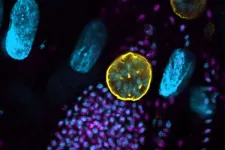(Press-News.org) INDIANAPOLIS — A study by Indiana University School of Medicine researchers sheds new light on how Toxoplasma gondii parasites make the proteins they need to enter a dormant stage that allows them to escape drug treatment. It was recently published with special distinction in the Journal of Biological Chemistry.
Toxoplasma gondii is a single-celled parasite that people catch from cat feces, unwashed produce or undercooked meat. The parasite has infected up to one-third of the world's population, and after causing mild illness, it persists by entering a dormant phase housed in cysts throughout the body, including the brain.
Toxoplasma cysts have been linked to behavior changes and neurological disorders like schizophrenia. They can also reactivate when the immune system is weakened, causing life-threatening organ damage. While drugs are available to put toxoplasmosis into remission, there is no way to clear the infection. A better understanding of how the parasite develops into cysts would help scientists find a cure.
Through years of collaborative work, IU School of Medicine Showalter Professors Bill Sullivan, PhD, and Ronald C. Wek, PhD, have shown that Toxoplasma forms cysts by altering which proteins are made. Proteins govern the fate of cells and are encoded by mRNAs.
"But mRNAs can be present in cells without being made into protein," Sullivan said. "We've shown that Toxoplasma switches which mRNAs are made into protein when converting into cysts."
Lead Author Vishakha Dey, PhD, a postdoctoral fellow at the IU School of Medicine and a member of the Sullivan lab, examined the so-called leader sequences of genes named BFD1 and BFD2, both of which are necessary for Toxoplasma to form cysts.
"mRNAs not only encode for protein, but they begin with a leader sequence that contains information on when that mRNA should be made into protein," Dey said.
All mRNAs have a structure called a cap at the beginning of their leader sequence. Ribosomes, which convert mRNA into protein, bind to the cap and scan the leader until it finds the right code to begin making the protein.
"What we found was that, during cyst formation, BFD2 is made into protein after ribosomes bind the cap and scan the leader, as expected," Dey said. "But BFD1 does not follow that convention. Its production does not rely on the mRNA cap like most other mRNAs."
The team further showed that BFD1 is made into protein only after BFD2 binds specific sites in the BFD1 mRNA leader sequence.
Sullivan said this is a phenomenon called cap-independent translation, which is more commonly seen in viruses.
"Finding it in a microbe that has cellular anatomy like our own was surprising," Sullivan said. "It speaks to how old this system of protein production is in cellular evolution. We're also excited because the players involved do not exist in human cells, which makes them good potential drug targets."
The Journal of Biological Chemistry featured the new study as an "Editor's Pick" paper, which represent a select group of the journal’s publications judged to be of exceptionally high quality and broad general interest to their readership.
"This paper describes a mechanism by which a parasite that causes toxoplasmosis in humans can respond to stress and allow the parasite to thrive," said George N. DeMartino, PhD, associate editor of the Journal of Biological Chemistry and a professor at the University of Texas Southwestern Medical Center. "The discovery of this mechanism provides a basis for treating these infections. Moreover, a similar mechanism is important in cancer, suggesting that it may be a therapeutic target for multiple human diseases."
Additional co-authors on the study include IU School of Medicine's Michael Holmes, PhD, and Matheus S. Bastos, PhD. The work was funded by the National Institutes of Health and the Showalter Foundation.
About the Indiana University School of Medicine
The IU School of Medicine is the largest medical school in the U.S. and is annually ranked among the top medical schools in the nation by U.S. News & World Report. The school offers high-quality medical education, access to leading medical research and rich campus life in nine Indiana cities, including rural and urban locations consistently recognized for livability. According to the Blue Ridge Institute for Medical Research, the IU School of Medicine ranks No. 13 in 2023 National Institutes of Health funding among all public medical schools in the country.
For more news, visit the IU School of Medicine Newsroom: medicine.iu.edu/news
END
Toxoplasma gondii parasite uses unconventional method to make proteins for evasion of drug treatment
2024-12-10
ELSE PRESS RELEASES FROM THIS DATE:
US e-scooter/e-bike injuries have tripled since 2019, fuelled by alcohol/substance use
2024-12-10
The numbers of e-scooter and e-bike injuries have tripled in the US since 2019, fuelled by alcohol and substance use, finds a nationwide analysis of emergency department visits, published online in the journal Injury Prevention.
And the odds of alcohol and substance use were much higher among 10-17 year old riders with these injuries than they were among older age groups, the findings show.
E-scooters and e-bikes, collectively known as micromobility devices, have become increasingly popular, thanks to their zero emissions, amid higher fuel prices and better biking infrastructure, note the researchers.
Emerging evidence points to increasing numbers of injuries associated ...
Cost stops 1 in 6 US adults with asthma from taking meds as prescribed, study suggests
2024-12-10
Despite a fall in the number of people with asthma over the past decade who say that cost has stopped them taking their meds as prescribed, financial hardship still remains a deterrent for 1 in 6 with the condition, suggests research published online in the respiratory medicine journal Thorax.
Failure to stick to their drug treatment was associated with a near doubling in the risk of an asthma attack and a more than 60% heightened risk of an emergency department visit, the findings indicate.
The findings reinforce the importance of healthcare policy in promoting equitable access to drug treatment, concludes a linked editorial.
In 2021, the Centers for Disease Control ...
Raising the standard in therapy with psychedelics
2024-12-10
Psychedelic substances like psilocybin (found in magic mushrooms), MDMA (commonly known as ecstasy), LSD (commonly known as acid), and ayahuasca have shown potential in treating conditions such as depression, post-traumatic stress disorder (PTSD), and addiction. These substances can induce profound psychological experiences that, when paired with psychotherapy — a form of talk therapy — have been proposed to lead to significant therapeutic benefits.
Why Now?
Despite the growing interest and media coverage, no major regulatory agency has yet approved psychedelics for specific medical use. Access to these treatments remains limited to clinical ...
Blood removal before major liver surgery cuts transfusions in half
2024-12-10
Removing 10 per cent of a patient’s blood before major liver surgery and giving it back afterwards reduced transfusions by half, according to a large clinical trial published in The Lancet Gastroenterology & Hepatology. Known as hypovolemic phlebotomy, this practice could save one in every 11 patients having this surgery from needing a transfusion.
“Blood loss is a major concern in liver surgery. Taking out half a litre of blood right before major liver surgery is the best thing we’ve found so far for reducing blood loss and transfusions,” said co-lead author Dr. Guillaume Martel, a surgeon and scientist who holds the Arnie Vered Family Chair in Hepato-Pancreato-Biliary ...
The Lancet Global Health: Most nations set to miss key global nutrition targets by 2030
2024-12-10
Despite a decade of global efforts, the world is far from reaching essential nutrition 2030 milestones set by the World Health Assembly, with critical gaps threatening the health of millions. According to a new Global Burden of Disease analysis, most countries are struggling to meet the six global nutrition targets set in 2012 to combat low birthweight, inadequate breastfeeding, child malnutrition, and anemia in reproductive-age women.
By 2021, limited success was seen with only a few countries meeting some of the targets: five countries achieved breastfeeding ...
EPA study finds that US public schools with the highest potential exposure risk to air toxics have higher proportions of disabled Latino, Hispanic, and Asian children
2024-12-10
EPA study finds that U.S. public schools with the highest potential exposure risk to air toxics have higher proportions of disabled Latino, Hispanic, and Asian children
Children are at greater risk from inhaled air pollutants than adults, as they have higher respiratory rates. Research has shown that air pollutants in the form of respiratory toxicants (such as some pesticides and solvents) can represent a significant health risk to children.
The Environmental Protection Agency (EPA) has completed a nationwide study to assess the estimated non-cancer exposure risks of public school ...
Treatment expectancies and psilocybin vs escitalopram for depression
2024-12-10
About The Study: This randomized controlled trial secondary analysis examines the association between treatment expectancies and the relative efficacy of psilocybin compared with escitalopram for major depressive disorder.
Corresponding Author: To contact the corresponding author, Ethan Dutcher, MD, PhD, email ethan.dutcher@ucsf.edu.
To access the embargoed study: Visit our For The Media website at this link https://media.jamanetwork.com/
(10.1001/jamapsychiatry.2024.4387)
Editor’s Note: Please see the article for additional information, including other authors, author contributions ...
“Missing link” between brain and body inflammatory signals identified in the skull
2024-12-10
New research from the Institute of Psychiatry, Psychology & Neuroscience (IoPPN) at King’s College London provides valuable insights into the brain-body immune connection identifying key communication hubs in the dural sinuses and skull bone marrow at the back of the head.
The research, which was supported by funding from the National Institute for Health and Care Research (NIHR) Maudsley Biomedical Research Centre (BRC) and published in the journal Brain, used neuroimaging techniques to establish that the dural sinuses, a region at the ...
Online training could help older adults communicate in noisy environments
2024-12-10
Online training that helps people recognise and understand new voices could be key to helping older adults improve communication in everyday environments, finds research by UCL experts.
The study, published in the Journal of Experimental Psychology: Applied, tested whether learned voices were easier to understand than unfamiliar voices in 20 older (55-73 years) and 20 younger (18-34 years) adults.
Participants took part in some preparatory online training, where they were trained to understand three new voices by listening to them each say 10 meaningful sentences until they became “familiar”.
They then had to listen to one of these voices speak ...
Short-term cognitive boost from exercise may last for 24 hours
2024-12-10
Short-term cognitive boost from exercise may last for 24 hours
The short-term boost our brains get after we do exercise persists throughout the following day, suggests a new study led by UCL (University College London) researchers.
Previous research in a laboratory setting has shown that people’s cognitive performance improves in the hours after exercise, but how long this benefit lasts is unknown.
The new study, published in the International Journal of Behavioral Nutrition and Physical Activity, ...


